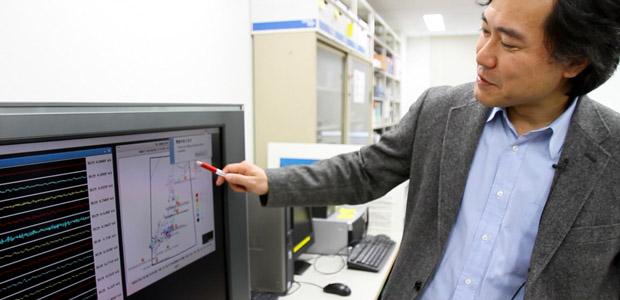Fears increase of big earthquake near Tokyo in the foreseeable future
University of Tokyo seismologist Shinichi Sakai’s controversial study predicts a major earthquake is likely to hit Tokyo within the next four years. (Photo by Sam Eaton.)
In a quiet room at Tokyo University, seismologist Shinichi Sakai points to steady, color-coded lines on a digital monitor. The screen displays real-time readings from Japan’s extensive network of seismometers.
This is one of the most seismically active countries in the world, and the flat lines show that all is quiet across the region, at least for the moment.
Then, as if on cue, two of the lines start to jump violently, splashing the screen with red and yellow pixels. They’re tracking a very small earthquake, centered just outside of Tokyo.
Sakai says small quakes like this happen about ten thousand times a year in Japan, and for geologists like him, even the small earthquakes are worth paying attention to. He says there’s been a fivefold increase in small tremors around Tokyo since the huge quake off Japan’s northeast coast in March last year. And that adds up to a mathematical omen for scientists like him.
In January, Sakai and the University’s Earthquake Research Institute crunched the new numbers and came up with a shocking prediction: There’s a 70 percent chance a major earthquake will hit Tokyo within the next four years.
Sakai and his colleagues are among the country’s leading seismic authorities, so the prediction itself gave the country a jolt. The Japanese government has also predicted a similar chance of a major quake in the Tokyo area, but over a longer time period — sometime in the next 30 years.
Sakai’s new four-year timeframe has brought a huge backlash among both scientists and political leaders. Sakai hasn’t retracted his prediction, but he now refuses to quote specific timeframes.
“I cannot speak,” he said, with an ironic chuckle.
The last major earthquake to hit Tokyo was in 1923. It had an estimated magnitude of 7.9 and killed more than 140,000 people. Since then there’s been almost no significant seismic activity here, and Sakai says that means most people have forgotten the risk Japan’s capital city still faces.
But not everyone has forgotten.
Yasuji Kamiya, 97, remembers it like it was yesterday.
Kamiya is one of the few remaining survivors of what’s known as the Great Kanto quake. He was 7 in 1923, living with his family in what was then a farming area on the outskirts of Tokyo.
He was fishing in a river on a bright sunny day when the quake hit. He said it knocked him over and shook the ground so violently that it emptied the river onto its banks.
Kamiya said it wasn’t until nightfall that he realized how serious the situation really was. The sky in the direction of downtown Tokyo glowed red from the fires consuming the city. Evacuees began to stream past his home. Some without shoes, all with stunned, empty looks on their faces.
Of course today Tokyo is a radically different place, a sprawling metropolis of some 35 million people. Every day, millions pack into the city’s spotless train network on their way to its forests of glass and steel office towers.
Modern Japanese buildings are among the sturdiest in world. After the 1995 Kobe earthquake, the country spent billions developing the most advanced technology for protecting structures. Still, the government estimates that a powerful quake in Tokyo today would kill nearly 10,000 people, and leave more than half a million buildings in flames.
But Sakai said accurately predicting potential damage is extremely difficult. That’s because it’s not just a question of magnitude, which refers to the energy of the quake. The actual intensity on the ground can vary greatly, depending on whether the quake’s epicenter is deep or shallow.
New evidence suggests a major fault line under Tokyo is much closer to the surface than previously thought. That means a future earthquake here could cause more damage than the city has been planning for.
After last year’s massive quake caught the nation by surprise, the Tokyo government began scrambling to upgrade its disaster plans. So far that means providing more emergency shelter and urging citizens and companies to stockpile emergency supplies.
But these efforts offer little comfort for many people.
“We’re not ready for that yet,” said Toru Seno. Seno, 43, is an artist and electrician. Every day he navigates Tokyo’s labyrinth of elevated highways and corridors of glass towers in his small van.
“If I look up, there’s another highway above me, so if something happens, all I can do is just stay here and get crushed,” he said.
Seno says not a minute goes by that he’s not planning his escape. But with last year’s disaster still fresh in everyone’s minds, the psychological toll of a major earthquake in Tokyo would be the hardest to recover from, he said.
“Probably the economy or industry somehow can be recovered,” Seno said. “But the damage for people would be hard. We would be feeling really weak.”
The government’s slow response to last year’s quake, tsunami and nuclear disaster has left trust in government here at all-time lows. For Seno, that means he’s more inclined to believe Sakai’s controversial prediction of a major quake in the next four years over the government’s longer timeframe.
And after recently visiting the fallout zone around the crippled Fukushima nuclear power plant, Seno says the most important message to remember here is that people need to protect themselves from earthquake risks, rather than wait for the government to do it for them.
